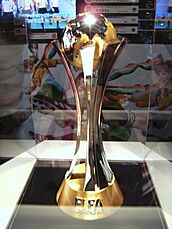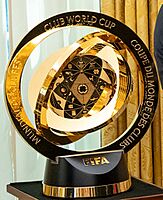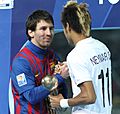FIFA Club World Cup facts for kids

The FIFA Club World Cup logo used since 2024
|
|
| Organising body | FIFA |
|---|---|
| Founded | 2000 |
| Region | International |
| Number of teams | 32 (from 6 confederations) |
| Related competitions | FIFA Intercontinental Cup |
| Current champions | (2nd title) |
| Most successful club(s) | (5 titles) |
The FIFA Club World Cup (also known as FIFA CWC) is a big international football competition for men's club teams. It is organized by FIFA, which is the main group that runs football around the world.
The tournament first started in 2000 as the FIFA Club World Championship. It took a break from 2001 to 2004 because of problems with FIFA's marketing partner. It came back in 2005 and was held every year until 2023. After the 2023 tournament, the competition changed. Now, it happens every four years, starting in 2025, and is much bigger, like the FIFA World Cup. The current champions are Chelsea, who won against Paris Saint-Germain 3–0 in the 2025 final.
The first FIFA Club World Championship was in Brazil in 2000. At that time, there was another competition called the Intercontinental Cup. This cup was played between the winners of the UEFA Champions League (Europe) and the Copa Libertadores (South America). In 2017, FIFA decided that the winners of both tournaments were officially "club world champions." In 2005, the Intercontinental Cup joined with the FIFA Club World Championship. In 2006, the tournament was renamed the FIFA Club World Cup. The winning team gets a special trophy and a FIFA Champions Badge.
The newest format, which began in 2025, has 32 teams playing for the title in the host country. These teams come from all over the world: 12 from Europe, 6 from South America, 4 from Africa, 4 from Asia, 4 from North, Central America, and the Caribbean, 1 from Oceania, and 1 team from the host nation. The teams are divided into eight groups of four. Each team plays three matches in its group. The top two teams from each group move on to the knockout stage, which starts with the Round of 16 and ends with the final match.
Real Madrid has won the most titles, with five wins. Corinthians was the first team to win the tournament in 2000, and they are the only host nation's national league champions to win it. Teams from Spain have won the tournament eight times, which is more than any other country. England has the most different winning clubs, with four teams having won the title.
Contents
History of the Club World Cup
Early Ideas for a World Championship
The idea of a "Football World Championship" for clubs goes way back to 1887. In that year, FA Cup winners Aston Villa played against Scottish Cup winners Hibernian. These were the only national competitions back then. Later, in 1895, English champions Sunderland beat Scottish champions Heart of Midlothian.
FIFA, the world football body, first thought about organizing a global club tournament in 1909. This was 21 years before the first FIFA World Cup for national teams. The Sir Thomas Lipton Trophy was held in Italy in 1909 and 1911. Teams from England, Italy, Germany, and Switzerland played in it. An English amateur team, West Auckland, won both times.
In the 1950s, people started thinking more seriously about FIFA organizing international club competitions. In 1951, the Brazilian Football Association created the Copa Rio. They hoped it would be a "Club World Cup." FIFA officials were interested, but it wasn't an official FIFA event. Palmeiras won the 1951 Copa Rio and were called the first "Club World Champions" by the Brazilian press.
Another tournament, the Pequeña Copa del Mundo (Spanish for Small World Cup), was held in Venezuela between 1952 and 1957. It usually had four teams, two from Europe and two from South America.
In 1960, FIFA approved the International Soccer League, which was also meant to be a Club World Cup. In the same year, the Intercontinental Cup began. This cup was played between the champions of Europe and South America.
The Intercontinental Cup and FIFA's Role
The Intercontinental Cup started in 1960. Real Madrid won the first one. They called themselves "world champions," but FIFA disagreed. FIFA said that the Intercontinental Cup only included teams from Europe and South America, so it wasn't a true "world" championship. FIFA wanted a competition that included teams from all continents.
Over the years, there were many discussions about making the Intercontinental Cup a FIFA event or creating a new, bigger Club World Cup. However, European and South American football groups often didn't agree to include teams from other continents. Sometimes, European champions even refused to play in the Intercontinental Cup.
To save the Intercontinental Cup, a Japanese company called Toyota Motor Corporation stepped in in 1980. They sponsored the competition, renamed it the Toyota Cup, and made it a single match played in Japan. This new format helped keep the competition going, as it offered good prize money to clubs.
The First FIFA Club World Championship (2000)
The idea for the FIFA Club World Championship really took off in the 1990s. FIFA felt it was time for a true global club tournament since each continent now had its own strong championship. Brazil was chosen to host the first competition, which was originally planned for 1999 but happened in 2000.
Eight teams from different continents played in the first tournament. These included Brazilian teams Corinthians and Vasco da Gama, England's Manchester United, and Spain's Real Madrid. The first goal was scored by Nicolas Anelka for Real Madrid. The final was an all-Brazilian match between Vasco da Gama and Corinthians. Corinthians won 4–3 in a penalty shootout after a 0–0 draw.
A second tournament was planned for Spain in 2001 with 12 clubs, but it was cancelled due to financial problems. Another attempt in 2003 also failed. Finally, FIFA decided to combine the Intercontinental Cup and the Club World Championship into one event. The last Intercontinental Cup was in 2004, and the new FIFA Club World Championship started in Japan in December 2005.
Knock-out Tournaments (2005–2023)
The 2005 version was shorter and easier to fit into the football calendar. It featured six continental champions, with teams from South America and Europe starting directly in the semi-finals. A new trophy was also introduced. São Paulo won the 2005 edition, beating Liverpool 1–0 in the final.
In 2006, Internacional kept the trophy in Brazil by defeating Barcelona in the final. However, in 2007, Italian club AC Milan broke the Brazilian winning streak, beating Boca Juniors 4–2 in the final. The next year, Manchester United won the 2008 title, beating LDU Quito 1–0.
The United Arab Emirates hosted the tournament in 2009 and 2010. Barcelona won in 2009, completing a historic "sextuple" (winning six major trophies in one year). In 2010, TP Mazembe from Congo became the first team from outside Europe or South America to reach the final, but they lost to Inter Milan.
The tournament returned to Japan for 2011 and 2012. Barcelona won their second title in 2011, beating Santos 4–0. In 2012, Corinthians won their second title, defeating Chelsea 1–0.
Morocco hosted in 2013 and 2014. In 2013, host team Raja CA made a surprise run to the final but lost to Bayern Munich. Real Madrid won their first Club World Cup in 2014, beating San Lorenzo 2–0.
Japan hosted again in 2015 and 2016. Barcelona won their third title in 2015. In 2016, Japanese team Kashima Antlers reached the final, but Real Madrid won 4–2 in extra time, with Cristiano Ronaldo scoring a hat-trick.
The UAE hosted again in 2017 and 2018. Real Madrid became the first team to win the trophy two years in a row in 2017. They then won a third straight title in 2018, beating Al-Ain 4–1 in the final. This made Real Madrid the first team to win the tournament four times.
Qatar hosted in 2019 and 2020. Liverpool won their first title in 2019. In 2020, Bayern Munich won, completing their "sextuple."
The 2021 edition was held in the UAE in 2022 due to the COVID-19 pandemic. Chelsea won their first title, beating Palmeiras 2–1 in extra time. The 2022 edition was held in Morocco in February 2023. Real Madrid won their record fifth title, beating Al-Hilal 5–3 in the highest-scoring final in the tournament's history. Manchester City was the last champion under this format, winning the 2023 edition.
Bigger Tournament (2025–Present)
In 2022, FIFA announced that the Club World Cup would become much bigger, with 32 teams, starting in June 2025. The United States was chosen to host this new, expanded tournament. The new format has eight groups of four teams. The top two teams from each group move on to a knockout stage.
This new, larger tournament has been welcomed by many football clubs and officials. They believe it will make the competition more exciting and give more visibility to football around the world. The 2025 edition also offered a much larger prize pool. Chelsea won the 2025 tournament, defeating Paris Saint-Germain 3–0 in the final.
Results
Finals
| Ed. | Year | Host | Final | Third place game | Num. teams |
Ref. | ||||
|---|---|---|---|---|---|---|---|---|---|---|
| Winners | Score | Runners-up | Third place | Score | Fourth place | |||||
|
|
|
|
|
|
||||||
|
|
|
|
|
|||||||
|
|
|
|
|
|
||||||
|
|
|
|
|
|
||||||
|
|
|
|
|
|
||||||
|
|
|
|
|
|
||||||
|
|
|
|
|
|
||||||
|
|
|
|
|
|
||||||
|
|
|
|
|
|
||||||
|
|
|
|
|
|
||||||
|
|
|
|
|
|
||||||
|
|
|
|
|
|
||||||
|
|
|
|
|
|
||||||
|
|
|
|
|
|
||||||
|
|
|
|
|
|
||||||
|
|
|
|
|
|
||||||
|
|
|
|
|
|
||||||
|
|
|
|
|
|
||||||
|
|
|
|
|
|
||||||
|
|
|
|
|
|
||||||
|
|
|
|
|
|
||||||
|
|
|
3–0 | Losing semi-finalists |
|
||||||
|
|
|
TBD |
|
|||||||
- Notes
Club Performance in the Tournament
| Club | Titles | Runners-up | Years won | Years runners-up |
|---|---|---|---|---|
| 5 | 0 | 2014, 2016, 2017, 2018, 2022 |
—
|
|
| 3 | 1 | 2009, 2011, 2015 | 2006 | |
| 2 | 1 | 2021, 2025 | 2012 | |
| 2 | 0 | 2000, 2012 |
—
|
|
| 2 | 0 | 2013, 2020 |
—
|
|
| 1 | 1 | 2019 | 2005 | |
| 1 | 0 | 2005 |
—
|
|
| 1 | 0 | 2006 |
—
|
|
| 1 | 0 | 2007 |
—
|
|
| 1 | 0 | 2008 |
—
|
|
| 1 | 0 | 2010 |
—
|
|
| 1 | 0 | 2023 |
—
|
|
| 0 | 1 |
—
|
2000 | |
| 0 | 1 |
—
|
2007 | |
| 0 | 1 |
—
|
2008 | |
| 0 | 1 |
—
|
2009 | |
| 0 | 1 |
—
|
2010 | |
| 0 | 1 |
—
|
2011 | |
| 0 | 1 |
—
|
2013 | |
| 0 | 1 |
—
|
2014 | |
| 0 | 1 |
—
|
2015 | |
| 0 | 1 |
—
|
2016 | |
| 0 | 1 |
—
|
2017 | |
| 0 | 1 |
—
|
2018 | |
| 0 | 1 |
—
|
2019 | |
| 0 | 1 |
—
|
2020 | |
| 0 | 1 |
—
|
2021 | |
| 0 | 1 |
—
|
2022 | |
| 0 | 1 |
—
|
2023 | |
| 0 | 1 |
—
|
2025 |
Country Performance in the Tournament
| Country | Titles | Runners-up | Years won | Years runners-up |
|---|---|---|---|---|
| 8 | 1 | 2009, 2011, 2014, 2015, 2016, 2017, 2018, 2022 | 2006 | |
| 5 | 2 | 2008, 2019, 2021, 2023, 2025 | 2005, 2012 | |
| 4 | 6 | 2000, 2005, 2006, 2012 | 2000, 2011, 2017, 2019, 2021, 2023 | |
| 2 | 0 | 2007, 2010 |
—
|
|
| 2 | 0 | 2013, 2020 |
—
|
|
| 0 | 4 |
—
|
2007, 2009, 2014, 2015 | |
| 0 | 1 |
—
|
2008 | |
| 0 | 1 |
—
|
2010 | |
| 0 | 1 |
—
|
2013 | |
| 0 | 1 |
—
|
2016 | |
| 0 | 1 |
—
|
2018 | |
| 0 | 1 |
—
|
2020 | |
| 0 | 1 |
—
|
2022 | |
| 0 | 1 |
—
|
2025 |
Confederation Performance
Teams from Africa that have done best are TP Mazembe (from Congo) and Raja CA (from Morocco). Both finished second in 2010 and 2013. From Asia, Kashima Antlers (Japan), Al-Ain (UAE), and Al-Hilal (Saudi Arabia) have finished second in 2016, 2018, and 2022. The best team from North America was UANL (Mexico), who finished second in 2020. These six clubs are the only ones from outside Europe and South America to reach the final.
Auckland City from New Zealand (Oceania) finished third in 2014. This is the only time an Oceanian team has reached the semi-finals.
| Confederation | Winners | Runners-up | Third place |
|---|---|---|---|
| UEFA | 17 | 4 | — |
| CONMEBOL | 4 | 11 | 5 |
| AFC | — | 3 | 5 |
| CAF | — | 2 | 4 |
| CONCACAF | — | 1 | 5 |
| OFC | — | — | 1 |
| Total | 21 | 21 | 20 |
How the Tournament Works
Before 2025, most teams qualified for the FIFA Club World Cup by winning their continental championships. These included the AFC Champions League (Asia), CAF Champions League (Africa), CONCACAF Champions League (North America), Copa Libertadores (South America), OFC Champions League (Oceania), or UEFA Champions League (Europe). The host nation's national league champions also got a spot.
As of 2025, the tournament has eight groups of four teams in the group stage. Teams play each other once in their group. They get three points for a win, one for a draw, and zero for a loss. The top two teams from each group move on to the knockout stage. If teams have the same points, other rules like goal difference are used to decide who moves forward.
The first tournament in 2000 had two groups, with the winners playing in the final. From 2005 to 2023, it was a knockout tournament. Teams played single matches, and if there was a tie, they went to extra time or a penalty shootout. This format had seven clubs. The host nation's club played against the Oceanian champions in the first round. The winner joined the champions from Africa, Asia, and North America in the second round. The winners of those games then played the European and South American champions in the semi-finals. The winners of the semi-finals played in the final. A match for fifth place was added but later removed. The match for third place was also removed after the 2023 edition.
The Trophies
The first trophy, used in 2000, was called the FIFA Club World Championship Cup. It was silver, weighed 4 kg, and had a football on top.
The second trophy, used from 2005 to 2023, was called the FIFA Club World Cup or la Copa. It was designed in England and unveiled in Tokyo in 2005. This gold-and-silver trophy weighed 5.2 kg and was 50 cm tall. Its design showed six pillars, representing the six continental champions, holding up a football-shaped globe.
For the expanded 32-team tournament starting in 2025, a new trophy was created. It was revealed in November 2024. This new trophy is worth about US$230,000 and is covered in 24-karat gold. It has detailed engravings, including a world map and the names of all FIFA member countries. It can even change shape, from a shield to a more complex structure.
Awards for Players and Teams
At the end of each Club World Cup, special awards are given out:
- The Golden Ball is for the best player in the tournament. Media members vote for this award. The players who come in second and third get the Silver Ball and Bronze Ball.
- The Player of the Match award is given to the best player in each game. This started in 2013.
- The FIFA Fair Play Trophy goes to the team that shows the best sportsmanship.
The team that wins the competition also gets a FIFA Champions Badge. This badge has a picture of the trophy and can be worn on the team's jersey until the next tournament's final. Milan was the first team to receive this badge in 2007.
The top three teams in each tournament also receive gold, silver, or bronze medals for their players.
Prize Money
| Winners | + $40 million |
| Runners-up | + $30 million |
| Semi-final | + $21 million |
| Quarter-final | + $13.125 million |
| Round of 16 | + $7.5 million |
| Group stage | $2 million per win $1 million per draw |
The first FIFA Club World Championship in 2000 had a total prize pool of US$28 million. The champions received US$6 million, while other teams got less depending on their final position.
When the tournament restarted in 2005, the total prize money was US$16 million. The winners received US$5 million. Over the years, the prize money changed slightly, for example, when a fifth-place match was added.
The new 2025 FIFA Club World Cup has a much larger prize pool of US$1 billion. The champions are expected to receive up to US$125 million.
Sponsors
Like the FIFA World Cup, the FIFA Club World Cup is sponsored by big international companies. Toyota Motor Corporation was a main partner until 2014. In 2015, Alibaba Group became the main partner for eight years. The first tournament in 2000 had six official sponsors, including McDonald's and MasterCard.
In June 2025, the Public Investment Fund (PIF) from Saudi Arabia became an official partner. Other big sponsors include Adidas, Coca-Cola, and Qatar Airways. While FIFA has its own sponsors, clubs can still wear jerseys with their own team sponsors.
Records and Statistics


Toni Kroos has won the FIFA Club World Cup six times, which is more than any other player. Cristiano Ronaldo has scored the most goals in the tournament's history, with seven goals. Hussein El Shahat has played in the most matches, with eighteen appearances.
Real Madrid has won the FIFA Club World Cup a record five times. They also have the most wins (16) and have scored the most goals (51) in the competition. Auckland City has played in the most tournaments (12 editions), while Al Ahly has played the most total matches (28).
Official Songs
The FIFA Club World Cup has had official songs for each tournament since 2005.
| Year | Hosts | Official songs/anthems | Language(s) | Performer(s) |
|---|---|---|---|---|
| 2005 | "Legendary Meadow" | Japanese | Chemistry | |
| 2006 | "Top of the World" | Japanese | ||
| 2007 | "Shining Night" | Japanese | Chemistry (supported by Monkey Majik) | |
| 2008 | "Septenova" | English and Japanese | Gospellers vs. Shintaro Tokita (from Sukima Switch) | |
| 2009 | "The River Sings" | Loxian | Enya | |
| 2010 | ||||
| 2011 | "Never Give Up" | Japanese | Kylee | |
| 2012 | "World Quest" | Japanese | NEWS | |
| 2013 | "Seven Colors" | English and Japanese | ||
| 2014 | ||||
| "Come Alive" | English | RedOne feat. Chawki | ||
| 2015 | "Anthem" | English | NEWS | |
| 2016 | ||||
| 2017 | "Kingdom" | English and Japanese | ||
| 2018 | "Spirit" | Japanese | ||
| 2019 | "Superstar" | Japanese | ||
| 2022 | "Welcome To Morocco" | English and Arabic | RedOne, Douzi, Hatim Ammor, Asma Lamnawar, Rym, Aminux, Nouaman Belaiachi, Zouhair Bahaoui, Dizzy DROS | |
| 2023 | "It's On" | English | Bebe Rexha, RedOne | |
| 2025 | "We Will Rock You" | English | Pitbull feat. RedOne |
Images for kids
-
Pep Guardiola is lifted by his team after Barcelona won the 2011 FIFA Club World Cup.
-
Corinthians won their second world title in 2012, with many fans traveling to Japan.
-
Zinedine Zidane at the 2017 FIFA Club World Cup. Real Madrid was the first team to win the trophy two years in a row.
-
Lionel Messi (left) with the Golden Ball award and Neymar (right) with the Bronze Ball after the 2011 final.
See also
 In Spanish: Copa Mundial de Clubes de la FIFA para niños
In Spanish: Copa Mundial de Clubes de la FIFA para niños









